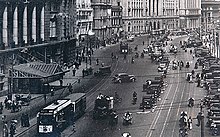
Back Nanjing-Dekade German Década de Nankín Spanish Décennie de Nankin French Dasawarsa Nanjing ID Decennio di Nanchino Italian Nankinas desmitgade Latvian/Lettish Nanjingdekaden NB Década de Nanquim Portuguese Нанкинское десятилетие Russian نانجنگ دہائی Urdu
This article needs additional citations for verification. (May 2020) |


The Nanjing decade (also Nanking decade, Chinese: 南京十年; pinyin: Nánjīng shí nián, or the Golden decade, Chinese: 黃金十年; pinyin: Huángjīn shí nián) is an informal name for the decade from 1927 (or 1928) to 1937 in the Republic of China. It began when Nationalist Generalissimo Chiang Kai-shek took Nanjing from Zhili clique warlord Sun Chuanfang halfway through the Northern Expedition in 1927. Chiang declared it to be the national capital despite the existence of a left-wing Nationalist government in Wuhan. The Wuhan faction gave in and the Northern Expedition continued until the Beiyang government in Beijing was overthrown in 1928. The decade ended with the outbreak of the Second Sino-Japanese War in 1937 and the retreat of the Nationalist government to Wuhan. GDP growth averaged 3.9 per cent a year from 1929 to 1941 and per capita GDP about 1.8 per cent.[1] Historians view the decade as a period of Chinese conservatism.[2][3][4]
Nanjing was of symbolic and strategic importance. The Ming dynasty had made Nanjing a capital, the republic had been established there in 1912, and Sun Yat-sen's provisional government had been there. Sun's body was brought and placed in a grand mausoleum to cement Chiang's legitimacy. Chiang was born in nearby Zhejiang and the general area had strong popular support for him.
The Nanjing decade was marked by both progress and frustration. The period was far more stable than the preceding Warlord Era. There was enough stability to allow economic growth and the start of ambitious government projects, some of which were taken up again by the new government of the People's Republic after 1949. Nationalist foreign service officers negotiated diplomatic recognition from Western governments and began to unravel the unequal treaties. Entrepreneurs, educators, lawyers, doctors, and other professionals were more free to create modern institutions than at any earlier time. However, the Nationalist government also suppressed dissent, corruption and nepotism were rampant and revolts broke out in several provinces; internal conflicts also perpetuated within the government. The Nationalists were never able to fully pacify the Chinese Communist Party, and struggled to address the widespread unrest and protests over their failure to check Japanese aggression.
- ^ Maddison, A. (1998). Chinese Economic Performance in the Long Run. Paris: OECD Development Centre.
- ^ Xu, Aymeric (2020). "Mapping Conservatism of the Republican Era: Genesis and Typologies". Journal of Chinese History 中國歷史學刊. 4 (1): 135–159. doi:10.1017/jch.2019.35. ISSN 2059-1632. S2CID 213926138.
- ^ Tsui, Brian (2018-04-19). China's Conservative Revolution: The Quest for a New Order, 1927–1949. Cambridge University Press. ISBN 978-1-108-16923-3.
- ^ Tsui, Brian Kai Hin (2013). China's Forgotten Revolution: Radical Conservatism in Action, 1927-1949 (Thesis). ProQuest 1271956595.
© MMXXIII Rich X Search. We shall prevail. All rights reserved. Rich X Search